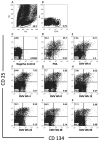Restoration of CMV-specific-CD4 T cells with ART occurs early and is greater in those with more advanced immunodeficiency
- PMID: 24130889
- PMCID: PMC3795037
- DOI: 10.1371/journal.pone.0077479
Restoration of CMV-specific-CD4 T cells with ART occurs early and is greater in those with more advanced immunodeficiency
Abstract
Objectives: Restoration of Cytomegalovirus-specific-CD4 T cell (CMV-Sp-CD4) responses partly accounts for the reduction of CMV-disease with antiretroviral-therapy (ART), but CMV-Sp-CD4 may also drive immune activation and immunosenescence. This study characterized the dynamics of CMV-Sp-CD4 after ART initiation and explored associations with CD4 T cell recovery as well as frequency of naïve CD4 T cells at week 96.
Methods: Fifty HIV-infected, ART-naïve Thai adults with CD4 T cell count ≤ 350 cells/µL and starting ART were evaluated over 96 weeks (ClinicalTrials.gov identifier NCT01296373). CMV-Sp-CD4 was detected by co-expression of CD25/CD134 by flow cytometry after CMV-antigen stimulation.
Results: All subjects were CMV sero-positive, 4 had quantifiable CMV-DNA (range 2.3-3.9 log10 copies/mL) at baseline but none had clinically apparent CMV-disease. Baseline CMV-Sp-CD4 response was positive in 40 subjects. Those with CD4 T cell count < 100 cells/µL were less likely to have positive baseline CMV-Sp-CD4 response (P=0.003). Positive baseline CMV-Sp-CD4 response was associated with reduced odds of quantifiable CMV-DNA (P=0.022). Mean CD4 T cell increase at week 96 was 213 cells/µL. This was associated positively with baseline HIV-VL (P=0.001) and negatively with age (P=0.003). The frequency of CMV-Sp-CD4 increased at week 4 (P=0.008), then declined. Those with lower baseline CMV-Sp-CD4 (P=0.009) or CDC category C (P<0.001) had greater increases in CMV-Sp-CD4 at week 4. At week 96, CD4 T cell count was positively (P<0.001) and the frequency of CMV-Sp-CD4 was negatively (P=0.001) associated with the percentage of naïve CD4 T cells.
Conclusions: Increases in CMV-Sp-CD4 with ART occurred early and were greater in those with more advanced immunodeficiency. The frequency of CMV-Sp-CD4 was associated with reduced naïve CD4 T cells, a marker associated with immunosenescence.
Conflict of interest statement
Figures


References
-
- Gallant JE, Moore RD, Richman DD, Keruly J, Chaisson RE (1992) Incidence and natural history of cytomegalovirus disease in patients with advanced human immunodeficiency virus disease treated with zidovudine. The Zidovudine Epidemiology Study Group. J Infect Dis 166: 1223-1227. doi:10.1093/infdis/166.6.1223. PubMed: 1358986. - DOI - PubMed
Publication types
MeSH terms
Substances
Associated data
LinkOut - more resources
Full Text Sources
Other Literature Sources
Medical
Research Materials

